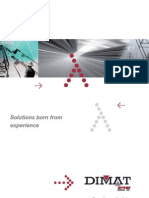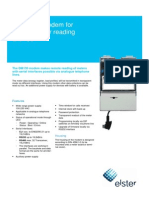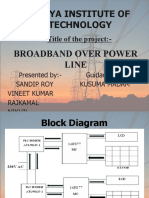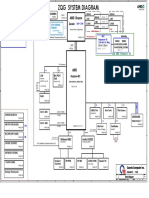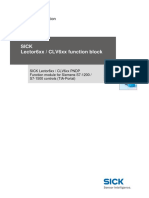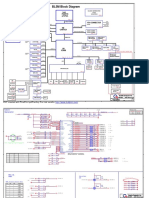583 - NSK5 Modem
583 - NSK5 Modem
Uploaded by
jayaCopyright:
Available Formats
583 - NSK5 Modem
583 - NSK5 Modem
Uploaded by
jayaOriginal Title
Copyright
Available Formats
Share this document
Did you find this document useful?
Is this content inappropriate?
Copyright:
Available Formats
583 - NSK5 Modem
583 - NSK5 Modem
Uploaded by
jayaCopyright:
Available Formats
IndustrialIT for Utility Communications
CommunicateIT FSK Data Transmission NSK5
A programmable modem for power utility
communication network.
For use in SCADA systems
NSK5 is a new frequency shift keyed modem
for the transmission of data over voice-grade
communication facilities. Already a success in
the marketplace, the modem is designed for
use in SCADA systems and allows both serial
asynchronous and synchronous data transmission. It uses binary frequency modulation
techniques which make it highly immune to
interference and noise and permit extensive
voice-band communication link utilization.
about 20 for the earlier NSK4
series to just 2 for the NSK5
generation underscores this key
benefit of the new design. NSK5
modems can be mounted either in
their own equipment tier or, when
used together with ABBs new
ETL power line carrier set, plugged
direct into reserved slots in this
equipment.
Module G4AF with alter-
Advanced microprocessor technology
The modem employs advanced microprocessor
technology, is fully programmable, and has no
frequency-dependent parts. Being microprocessor-based, it offers high service flexibility
and significantly reduces hardware inventories.
A reduction in the number of modules from
nate routing
Rear view of NSK5 (for
19 racks) with interface
cables
Possible utilization of audio band (frequency multiplexing)
Speech
Telecontrol and data band
NSK 5
Telecontrol and data band
ITU-T
Data channels
Pilot
ETL
420
540
660
780
900
1020
1140
1260
1380
1500
1620
1740
1860
1980
2100
2220
2340
2460
2580
2700
2820
2940
3060
3180
3300
3420
3540
3660
3780
3900
2000 Hz
50 Bd
120 Hz
R.35
480 720 960 1200 1440 1680 1920 2160 2400 2640 2880 3120 3360 3600 3840
100 Bd
240 Hz
R.37
540
900
1260
1620
1980
2340
3060
200 Bd
360 Hz
R.38B
1560
2040
2520
3000
3480
200 Bd
480 Hz
R.38A
600
1080
1560
2040
2520
3000
3480
300 Bd
480 Hz
420
TX
3780
1080
600 Bd
960 Hz
2760
1200 Bd
2400 Hz
V.23
Speech or data channels
1980
1700
1200 Bd
+ speech
1640 Hz
ETL
2860
2400 Bd
3200 Hz
1800/2000
300
3420
600
1320
420
2700
1000
2000
3000
4000 Hz
RX
RX
RX
TX
TX
NSK5: Technical Data
ITU-T
Transmission
rate
(nom./max.)
Bd
Hz
R35
50/75
30
120
420
3900
R37
100/150
60
240
480
3840
R38B
200/225
90
360
540
3780
R38A
200/200
120
480
600
3840
300/300
600
120
400
480
960
600
840
3840
3600
1200
1200 + speech
2400
400
400
800
2400
1640
3200
V23
Frequency
deviation
Channel
spacing
(bandwidth)
Hz
Channel mean frequency
adjustable in steps of 120 Hz
lowest
highest
Hz
Hz
1700
2860
1800/2000
Interfaces
Inputs
ITU-T V.10/V.28/RS232D/RS423A
Outputs
ITU-T V.28/RS232D
Transmit level to line
024 dBm
Receive level range
853 dBm
Power supply from 24 V battery
20.433 V/185 mA
Supply units
DC/DC converter
for 48/60/110 V batt. (+25%/40%)
AC/DC converter
for 110/230 VAC (+15%/15%)
Insulation (AC 50 Hz 1 minute)
Electronics against protective ground
2 kV
AF lines against supply input, protective ground and data interfaces
2 kV
EMC
in compliance with
VDE871/B, VDE878, CE
Mechanical design (width x height x depth)
Modem with alternate routing
40.6 x 266.7 x 220 mm
Modem without alternate routing
30.5 x 266.7 x 220 mm
Subrack
485 x 270 x 280 mm
Modifications or deviations which are due to technical progress are reserved.
Block diagram of the
NSK5 modem (G4AE/G4AF)
24 V battery
Input interface
(data and control signals)
3 Output interface
(data and control signals)
4 Carrier failure delay
5 Program switches
6 Test switch
7 Multiplexer
8 Internal supply voltages
9 Carrier failure alarm
10 Digital signal processor
11 Monitor
12 Equipment alarm
13 Main line, receive
14 Backup line, receive
15 Main line, transmit
16 Backup line, transmit
A/D Analog/digital converter
Only with G4AF
*
+ 12 V
+ 5V
0V
5V
12 V
DC
DC
1
2
TXD
RTS
DTR
LL
ISP
SEL
SG
V 24
V 28
RS 232
V 24
V 28
RS 232
8 bit bus
S1
S2
S3
S4
3
t
4
7
8
10
A/D
13
14
*
*
RXD
DCD
CTS
DSR
RCK
TI
TCK
11
12
D/A
15
* 16
One module for all channels
A programmable NSK5 modem contains a
complete transmitter and receiver, including
line equipment and line transformers, a galvanically isolated power supply, and a type RS
232 C, D/V.24/V.28 data interface. Also included
are a number of useful extra functions previously
available only with special add-on modules at
extra cost.
Highlights
A choice of synchronous or asynchronous
data transmission
Data can be transmitted either in asynchronous
mode with speed and code transparency and
without clock signals, or in synchronous
mode with a clock signal provided at both the
transmitting and receiving end of the modem.
Integrated data regeneration
As an option, the modem can be made to
regenerate the data at the receiving end to
eliminate unacceptably high pulse distortion,
which can occur occasionally in a critical
transmission path. This reduces the users costs
and simplifies project engineering; the integrated regenerator function is simply enabled
whenever it is required.
Amplitude equalizer for long cables
An amplitude equalizer to compensate for frequency-dependent attenuation distortion on
long cables is a standard feature of the NSK5
modem. The user simply selects the most
suitable equalizer for his link using the program
switches.
Integrated line switchover unit
A version of the modem with integrated line
switchover facility is also available. With this
option, transmission is automatically continued
over the backup line if the main path fails.
This modem is for users desiring an even higher
transmission availability.
Galvanically isolated module power supply
A built-in voltage converter with 2 kVrms
insulation level prevents earth (ground) loops
between the modems in the subrack and
between the modems and the main power
supply. The modem can be fed direct from a
24 V battery or from other voltage sources
with separate DC/DC or AC/DC converter
mounted in the equipment tier.
NSK5 can be mounted in a subrack
A separate equipment tier, with the option
of redundant main power supplies for all the
common supply voltages, can accommodate
up to 9 modems. The signal cables can be
connected either to the front or to the rear of
the modem.
or plugged into ETL power line carrier
equipment
The modem can also be plugged into reserved
slots in ABBs ETL power line carrier unit. Up to
five modems may be inserted, depending on
the extent to which the ETL system is utilized.
Users choosing this option do not need a
separate NSK5 equipment tier with its own
power supply.
1200 bauds plus speech transmission
Using a standardized channel with special
equalizer, and with the modem plugged into
the ETL equipment, a data channel with
1200 bits/s can be operated on top of the
300 to 2000 Hz band used for the speech
channel.
Up to 2400 bauds
Signalling rates of 2400 bits/s are possible with
FSK, providing the total speech bandwidth of
300 to 3400 Hz is available. The program
switches are used to select standard speeds, as
well as 2400 bauds for pilot wire or PLC transmissions with special equalization.
Comprehensive test facilities
Data terminal equipment can request a local
analog test loop conforming to ITU-T V.54
(loop 3) by means of the signal LL (for Local
Loop). This involves a transmitted message
being looped back to the receiver at a point
immediately before the line transformers,
resulting in local reception of a message.
There is also a switch on the front panel for
initiating self-testing of the modem.
Advantages of NSK5 Modem
in short
The frequency shift keyed NSK5 modem
is designed for use in SCADA and offers
you a set of advantages:
Amplitude equalizer for long cables to compensate for frequency-dependent attenuation
distortion
Integrated line switchover unit to automatically
continue transmission over the backup line
if the main path fails
Fully programmable due to advanced
microprocessor technology
Highly immune to interference and
noise as a result of its binary frequency
modulation techniques
Consists of a complete transmitter/
receiver, including line equipment, line
transformers, a galvanically isolated
power supply and different types of
data interfaces
Serial asynchronous and synchronous
data transmission over voice-grade
communication facilities
Integrated data regeneration to eliminate
unacceptably high pulse distortion
ABB Switzerland Ltd
Utility Automation Systems
Brown Boveri Strasse 6
CH-5400 Baden/Switzerland
Phone +41 - 58 589 37 35
or
+41 - 844 845 845 (Call Center)
Fax
+41 - 58 585 16 82
e.Mail utility.communication@ch.abb.com
www.abb.com/utilitycommunications
Can be plugged into ETL power line carrier
equipment or mounted in separate equipment
tier
Can operate at 1200 to 2400 bauds
plus speech transmission
Comprehensive test facilities
1KHA-000 583-SEN
2000 03.03 Printed in Switzerland
ABB Switzerland Ltd, March 2003.
The right to modifications or deviations due to technical progress is reserved.
You might also like
- Network Management System A Complete Guide - 2020 EditionFrom EverandNetwork Management System A Complete Guide - 2020 EditionRating: 5 out of 5 stars5/5 (1)
- IT Operations Management Team A Complete Guide - 2021 EditionFrom EverandIT Operations Management Team A Complete Guide - 2021 EditionNo ratings yet
- Kavach: Cab Signalling & Automatic Train Protection System for Digital RailwaysFrom EverandKavach: Cab Signalling & Automatic Train Protection System for Digital RailwaysNo ratings yet
- ABB - Product Portfolio For MV Outdoor and Underground Networks - A4 - ENGDocument6 pagesABB - Product Portfolio For MV Outdoor and Underground Networks - A4 - ENGMartínCárdenasOyarseNo ratings yet
- Remote Notice Board Using GSM With SmsDocument14 pagesRemote Notice Board Using GSM With SmsMikroc Thupati SrinivsNo ratings yet
- SCD5200 Dual Communications ModulesDocument8 pagesSCD5200 Dual Communications ModulesWisnu HartonoNo ratings yet
- Microscada Pro Sys 600cDocument6 pagesMicroscada Pro Sys 600cDulon22No ratings yet
- DIMAT Product Guide English Rev.4Document16 pagesDIMAT Product Guide English Rev.4bansalrNo ratings yet
- IA Series Hardware FBM 218 HARTDocument12 pagesIA Series Hardware FBM 218 HARTRobert VillavicencioNo ratings yet
- Smartstruxure Lite Solution: MPM Series Multi-Purpose Manager (Mpm-Un)Document4 pagesSmartstruxure Lite Solution: MPM Series Multi-Purpose Manager (Mpm-Un)Robson FernandesNo ratings yet
- A Versatile Low-Power Power Line FSK TransceiverDocument4 pagesA Versatile Low-Power Power Line FSK TransceiverLuciana JovinianoNo ratings yet
- Pulse Autonom 3052 PDFDocument8 pagesPulse Autonom 3052 PDFRobert RodriguezNo ratings yet
- Microwave Nec Pasolink Neo by Akash RayDocument48 pagesMicrowave Nec Pasolink Neo by Akash RayAntonio P. Souza JuniorNo ratings yet
- Data SheetDocument40 pagesData SheetMohamed YuosefNo ratings yet
- ABB - Product Portfolio For MV Outdoor and Underground Networks - A4 - ENG PDFDocument6 pagesABB - Product Portfolio For MV Outdoor and Underground Networks - A4 - ENG PDFAgung PrasetyaNo ratings yet
- Feeder Protection and Control: Relion 615 SeriesDocument8 pagesFeeder Protection and Control: Relion 615 SeriesVenkat RamanNo ratings yet
- 1MRK505188-BEN B en BuyerAs Guide Line Differential Protection IED RED 670 Pre-Config 1.1Document56 pages1MRK505188-BEN B en BuyerAs Guide Line Differential Protection IED RED 670 Pre-Config 1.1Anonymous BBX2E87aHNo ratings yet
- 1511 MAX DsDocument4 pages1511 MAX DsOchie RomeroNo ratings yet
- 2400S PDSDocument12 pages2400S PDSPrashanthMNairNo ratings yet
- SISTEMA Onda PortadoraDocument12 pagesSISTEMA Onda PortadoraLuis Vargas DiazNo ratings yet
- Microcontroller Based Wireless Bus Station IdentificationDocument35 pagesMicrocontroller Based Wireless Bus Station IdentificationAbha Singh100% (2)
- 6370 mp-2100.pdf&isFromRegistration 1Document4 pages6370 mp-2100.pdf&isFromRegistration 1Xuân TrườngNo ratings yet
- ALSTOM Track Circuits 2011 12Document16 pagesALSTOM Track Circuits 2011 12StTang0% (2)
- Ubs ModDocument14 pagesUbs ModPatricio Andres100% (2)
- Sat - Ak-1703-Acp - PDF (1.004kb)Document6 pagesSat - Ak-1703-Acp - PDF (1.004kb)Kültigin KaracaNo ratings yet
- ARDUINO BASED WIRELESS ELECTRONIC NOTICE BOARD USING GSM MODEM Ijariie13835Document9 pagesARDUINO BASED WIRELESS ELECTRONIC NOTICE BOARD USING GSM MODEM Ijariie13835Faran JeeNo ratings yet
- VHF Am Digital RadioDocument4 pagesVHF Am Digital RadioEmrehan KocamışNo ratings yet
- Numerical Generator Protection Reg216 Reg216 ClassicDocument52 pagesNumerical Generator Protection Reg216 Reg216 ClassicRaviteja NowduruNo ratings yet
- Overview As InterfaceDocument24 pagesOverview As InterfaceElí Viliams Villanera SánchezNo ratings yet
- Gama Dimat Catalog Be17Document16 pagesGama Dimat Catalog Be17ELMIR ADILNo ratings yet
- Performance of Power Line Communication Systems With Noise Reduction Scheme For Smart Grid ApplicationsDocument4 pagesPerformance of Power Line Communication Systems With Noise Reduction Scheme For Smart Grid ApplicationsSwati DubeyNo ratings yet
- Analog Front End For 3G Femto Base Stations Brings Wireless Connectivity HomeDocument5 pagesAnalog Front End For 3G Femto Base Stations Brings Wireless Connectivity Homeas147No ratings yet
- Datasheet 100G 40kmLITEDocument12 pagesDatasheet 100G 40kmLITEbeirizNo ratings yet
- 1.0 Features: Virtual Com Port (VCP) Drivers For Hardware FeaturesDocument26 pages1.0 Features: Virtual Com Port (VCP) Drivers For Hardware FeaturesvijaykannamallaNo ratings yet
- DX80G9M6S-PB2 SureCross Performance Gateway Module 163211Document11 pagesDX80G9M6S-PB2 SureCross Performance Gateway Module 163211Lovan SoNo ratings yet
- DM705SUBDocument7 pagesDM705SUBManoel MessiasNo ratings yet
- CBM6 Q108 Product BulletinDocument1 pageCBM6 Q108 Product BulletinikurtogluNo ratings yet
- Less Is More: Versatile Single Radio 802.11A/B/G/N Wireless Access PointDocument4 pagesLess Is More: Versatile Single Radio 802.11A/B/G/N Wireless Access PointBry ÁlvarezNo ratings yet
- Gwy 300Document5 pagesGwy 300Maitry ShahNo ratings yet
- ABB LMU 574 - mcd80Document12 pagesABB LMU 574 - mcd80gadware2011bplNo ratings yet
- Chap 1Document92 pagesChap 1Arth PatelNo ratings yet
- Scadapack 330 Scadapack 334 DatasheetDocument4 pagesScadapack 330 Scadapack 334 DatasheetAqua Technology GroupNo ratings yet
- Thuderbolt Tech GuideDocument7 pagesThuderbolt Tech GuideabhinandNo ratings yet
- DM130 Flyer EDocument2 pagesDM130 Flyer Eahmad7160No ratings yet
- Jotron 7000 SeriesDocument4 pagesJotron 7000 SeriesZoheir Redouane Zahzah100% (1)
- Communication Antenna Switching System Based On Micro ControllerDocument4 pagesCommunication Antenna Switching System Based On Micro ControllerAjay Kumar YadavNo ratings yet
- 2nd Review DocumentDocument6 pages2nd Review DocumentBrightworld ProjectsNo ratings yet
- BLN 95 9041Document5 pagesBLN 95 9041marsh2002No ratings yet
- S000e Pakscan Systems GlossyDocument16 pagesS000e Pakscan Systems Glossyhizbi7No ratings yet
- FBM207Document16 pagesFBM207Morenazo20No ratings yet
- Optoisolation and Optical Sensor Products: Selection GuideDocument64 pagesOptoisolation and Optical Sensor Products: Selection GuidetorinomgNo ratings yet
- 1215 DatasheetDocument7 pages1215 DatasheetAnil JosephNo ratings yet
- Acharya Institute of Technology Broadband Over Power Line: Title of The ProjectDocument24 pagesAcharya Institute of Technology Broadband Over Power Line: Title of The ProjectroysandyNo ratings yet
- SCD5200 CPU OptoNet Power Supply Ethernet (COPE) ModuleDocument8 pagesSCD5200 CPU OptoNet Power Supply Ethernet (COPE) ModuleWisnu HartonoNo ratings yet
- Microwave Nec Pasolink Neo by Akash RayDocument48 pagesMicrowave Nec Pasolink Neo by Akash RayPepe LuchoNo ratings yet
- DataSheet Ms 9200UDDocument4 pagesDataSheet Ms 9200UDAngel R RodriguezNo ratings yet
- High-Performance D/A-Converters: Application to Digital TransceiversFrom EverandHigh-Performance D/A-Converters: Application to Digital TransceiversNo ratings yet
- Standby Plante140704Document59 pagesStandby Plante140704jayaNo ratings yet
- Eamcet-2012 Admissions: A.P.State Council of Higher Education, A.P., HyderabadDocument2 pagesEamcet-2012 Admissions: A.P.State Council of Higher Education, A.P., HyderabadjayaNo ratings yet
- Part 1Document10 pagesPart 1jayaNo ratings yet
- Motor Car/Motor Cycle/ Scooter/Moped: FORM No-4Document12 pagesMotor Car/Motor Cycle/ Scooter/Moped: FORM No-4jaya100% (2)
- 547 PLC Engineering FinalDocument8 pages547 PLC Engineering FinaljayaNo ratings yet
- Acer Aspire 4253 (Quanta ZQG) PDFDocument41 pagesAcer Aspire 4253 (Quanta ZQG) PDFIrsan Aditya IrsanNo ratings yet
- Troubleshooting Log Files in DominoDocument68 pagesTroubleshooting Log Files in DominoputertutorNo ratings yet
- Hard Drive. Most Personal Computers Have Atleast One Hard Drive. TheDocument4 pagesHard Drive. Most Personal Computers Have Atleast One Hard Drive. TheMisba RaniNo ratings yet
- Data Dictionary and What Are Main Functions of Data Dictionary in SAP ?Document31 pagesData Dictionary and What Are Main Functions of Data Dictionary in SAP ?KIRANNo ratings yet
- Configuration of Direct Starters With FBSWTMMS enDocument25 pagesConfiguration of Direct Starters With FBSWTMMS enaharnishaNo ratings yet
- Device Technology & Pervasive Compu7ng: Rahul BanerjeeDocument41 pagesDevice Technology & Pervasive Compu7ng: Rahul BanerjeeAbhishek KadiyalaNo ratings yet
- Lesson 8: Information Systems Security and ControlDocument6 pagesLesson 8: Information Systems Security and ControlsolocheruicNo ratings yet
- Sick Lector6xx / CLV6xx Function Block: Technical InformationDocument24 pagesSick Lector6xx / CLV6xx Function Block: Technical InformationPiotr BzdręgaNo ratings yet
- Toshiba Satellite P300 P305 (Quanta BL5M) Laptop SchematicsDocument37 pagesToshiba Satellite P300 P305 (Quanta BL5M) Laptop SchematicsRazafimamonjy Elie J HerminotNo ratings yet
- SAP S/4HANA, On-Premise Edition Trial: A Step by Step Guide To Help You Start Your 30 Day TrialDocument14 pagesSAP S/4HANA, On-Premise Edition Trial: A Step by Step Guide To Help You Start Your 30 Day TrialPanneerselvanTKNo ratings yet
- Computer Chapter 1Document7 pagesComputer Chapter 1api-217232127100% (1)
- Computer Architecture PDFDocument18 pagesComputer Architecture PDFMuhammad Mehroz BadshahNo ratings yet
- Bluehill Universal BrochureDocument24 pagesBluehill Universal BrochureSoo SeoNo ratings yet
- NXP CanDrv IntegrationHintDocument59 pagesNXP CanDrv IntegrationHintNguyễn Lê Nhật ThắngNo ratings yet
- Installing QGIS PluginsDocument3 pagesInstalling QGIS PluginsBibhuti Bhusan SahooNo ratings yet
- 7.2previewing, Final Rendering, Compositing in Various FormatsDocument9 pages7.2previewing, Final Rendering, Compositing in Various Formatskhasim9896No ratings yet
- IIIT Surat Curriculum CSEDocument6 pagesIIIT Surat Curriculum CSEswadhinNo ratings yet
- Hill CH 2 Ed 3Document61 pagesHill CH 2 Ed 3Tamiru HailuNo ratings yet
- PFRODocument3 pagesPFRORsam SamrNo ratings yet
- CPE 169 Experiment 1: The Big PointDocument25 pagesCPE 169 Experiment 1: The Big Pointsutekidane7435No ratings yet
- Modern Operating SystemsDocument39 pagesModern Operating SystemskooshanflmNo ratings yet
- GS3 Environment Notes - Anudeep AIR 1Document34 pagesGS3 Environment Notes - Anudeep AIR 1Jamman AyeshaNo ratings yet
- Presentation Hotspot PDFDocument27 pagesPresentation Hotspot PDFbayu prakosoNo ratings yet
- Send GSM SIM800 900 GPRS Data To Thingspeak With ArduinoDocument21 pagesSend GSM SIM800 900 GPRS Data To Thingspeak With Arduinodhunter ZenfoneNo ratings yet
- Barcode ProjectDocument14 pagesBarcode ProjectSrujan Rajkumar ReddyNo ratings yet
- SRX Juniper PDFDocument19 pagesSRX Juniper PDFAnaya RABAH0% (1)
- Rfid Based Telemedicine SystemDocument18 pagesRfid Based Telemedicine SystemTilottama DeoreNo ratings yet
- Manual Bristol Rtu 3305 Remote Terminal Unit Ras en 133582 PDFDocument348 pagesManual Bristol Rtu 3305 Remote Terminal Unit Ras en 133582 PDFadesa2013No ratings yet
- Backup Exec Deduplication Option's Deduplication Engine (Spoold) Fails To Start Due To Files Deleted - Quarantined by Antivirus SoftwareDocument3 pagesBackup Exec Deduplication Option's Deduplication Engine (Spoold) Fails To Start Due To Files Deleted - Quarantined by Antivirus SoftwareMario TabuadaNo ratings yet
- WinCC Flexible SQL Database Archive enDocument34 pagesWinCC Flexible SQL Database Archive enpremchandarNo ratings yet










